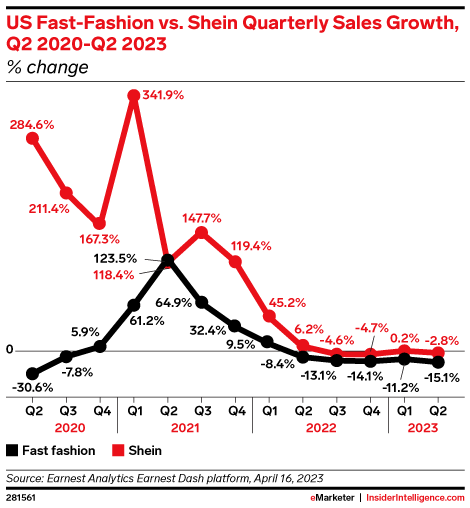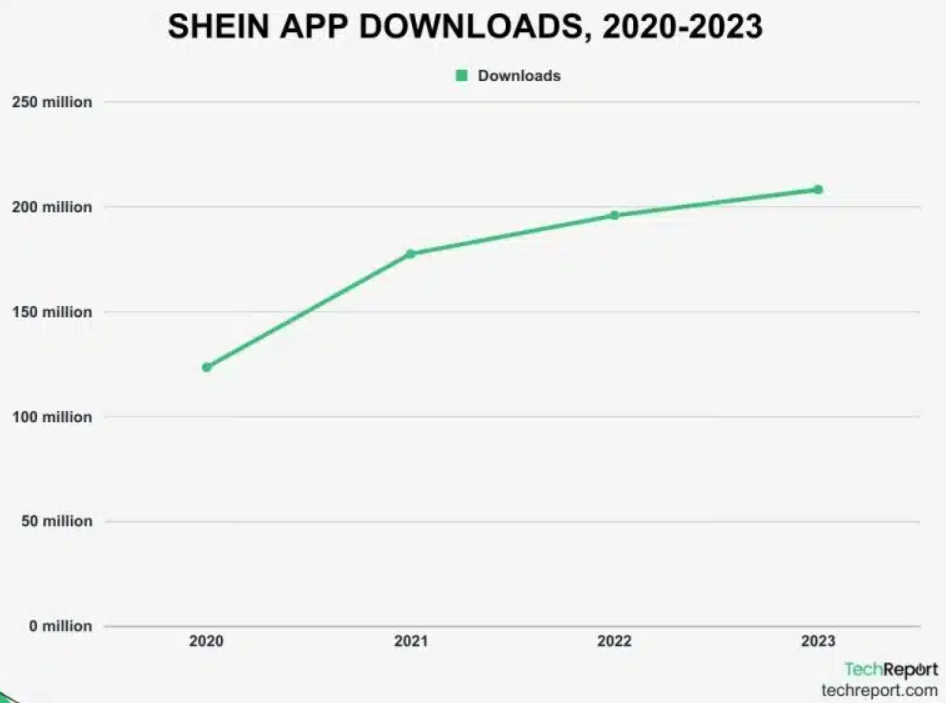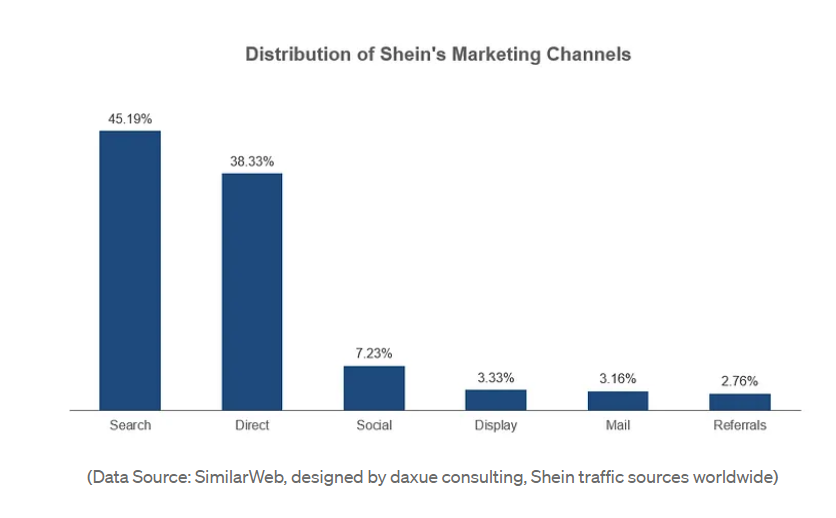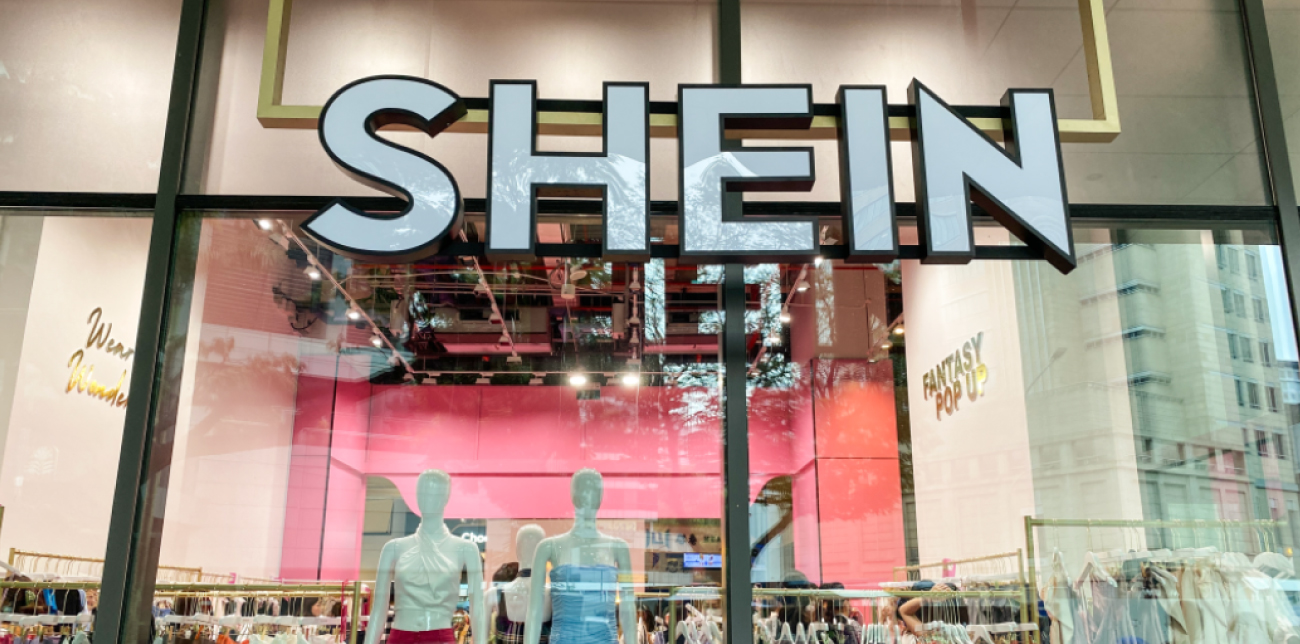Chinese fast-fashion brand Shein emerged in 2012, swiftly positioning itself in the market by engaging influencers on social media. Over the following decade, Shein experienced remarkable growth, culminating in its status as one of the largest fashion brands globally by 2022, with a revenue of $22.7 billion that year. The brand aims to go public in 2024, marking another milestone in its impressive journey. The Shein marketing strategy has been a significant factor in the company’s success. Discover more about Shein’s origins and how its omnichannel marketing approach has enabled it to grow and compete with other renowned fashion brands.
✔️ In a rush? Tune in while you’re on the move.
Shein: The history of the Chinese fashion titan
Shein was founded in 2008 on the premise that fashion should be accessible to people of all income levels. The company’s founder, Chris Xu, noticed that consumers were starting to deviate from fashion norms, and dressing for their style rather than shopping for trending items. To cater to these customers, Shein began to offer a wider variety of items than other fashion retailers and used a digital-first strategy that enabled customers to shop online rather than going to a physical store.
Since its inception, the Shein marketing strategy has always prioritized its social media presence, website, and app to appeal to its target demographic. Shein currently utilizes multiple distribution centers in locations across the globe to deliver merchandise quickly and affordably.

Build smarter customer journeys and activate AI-driven personalization for repeat purchases.
3 must-watch videos about Shein for retail executives
How Shein built a $66b fast-fashion empire
This video by the Wall Street Journal sheds light on Shein’s dominance in the global fast-fashion market, highlighting its reputation as one of the least transparent companies in the industry. Shein attributes its ability to offer low-cost clothing to its sophisticated monitoring of user behavior, which helps predict customer demand and its practice of producing items in small batches. This Chinese e-commerce giant, famous for its $5 T-shirts and $20 cocktail dresses, commands 40% of the U.S. fast-fashion market, generating an estimated $8 billion in sales in the country last year. Shein’s inventory turnover rate is twice that of competitors like H&M and Zara.
Shein’s INSANE growth
This video by IWD Agency explores how Shein managed to grow from a small online wedding dress retailer to one of the biggest brands in fashion using clever social media strategies. It also explains how the company uses an operating model similar to drop shipping. Rather than designing and manufacturing clothes, Shein partners with Chinese wholesalers.
In its early days, the Shein marketing strategy used social media, including Instagram, to market to Gen Z. But its biggest success came with a TikTok challenge in 2020 urging influencers and others on social media to buy in bulk and showcase their hauls in videos. The video also talks about the company’s rewards strategy and how its algorithm helps personalize recommendations and drive engagement on the website.
How Shein outsold its competitors
This video, posted by CNBC International, explores multiple aspects of Shein’s retail strategy and how the company managed to pass established fast-fashion retailers such as ASOS and H&M. Many companies interested in doing business with Chinese customers focused on smartphone users as technology became more popular.
To capture users outside China, Shein used Chinese marketing tactics to its advantage. Its home country has multiple smartphone users and a rich history of data mining to market to them. Shein used this tactic to amplify its supply chain and to develop a customer loyalty program and other marketing strategies that would attract a digital-first audience.
Shein’s business performance: The most interesting charts
Because the company has risen so quickly in the fashion market, it’s easy to think that the Shein marketing strategy is slightly exaggerated, but these charts tell the real story.
Shein’s market share

Since 2019, Shein has experienced significant growth in the United States and managed to overtake its primary competitors during the COVID-19 pandemic. Its growth in the country has held steady, and the company was the only fast-fashion retailer to experience growth in the U.S. between November 2021 and November 2022.
Shein’s sales growth chart

Shein, the fast fashion giant, has reported its highest-ever net profit for the first half of 2023. This marked a significant turnaround from the near-break-even performance during the same period in 2022. The company’s impressive financial results were driven by strong growth in key markets, particularly the U.S. and Brazil. Shein’s new marketplace strategy, which allows third-party vendors to sell on its platform, played a crucial role in this success, with the Brazilian marketplace contributing significantly to overall sales
Shein’s app downloads

After successfully tapping into the eCommerce market in 2020, Shein’s app downloads have grown consistently. Its downloads topped 100 million that year and increased to over 200 million by the end of 2023.
Decrypting the Shein marketing strategy and its business model
So how did this company become so successful? The Shein retail strategy has been successful because of a variety of factors.
Fast fashion on a global scale

Before the 1960s. fashion primarily operated within two major seasonal cycles, spring and fall. In most cases, major fashion designers would showcase their collections during the four major fashion weeks, and buyers for retailers would choose which trends to incorporate into their stores. In the 1960s, young people wanted different clothes than their parents, and fashion brands began outsourcing manufacturing to keep up.
In the 1990s, brands such as H&M and Zara changed the landscape by quickly producing more affordable versions of trendy clothing faster than ever. Major retailers eventually followed suit, stocking new inventory more often. Shein and other digital-first retailers took this same concept and drastically sped up the cycle.
The company uses real-time data to predict supply and demand and uses a small-batch, on-demand manufacturing model to deliver the trendiest items to customers around the world more accurately. By using this model, the company saves on inventory storage costs and passes these savings down to customers.
Shein also strategically partners with logistics providers to improve shipping capabilities and deliver faster to customers outside of China.
The role of eCommerce in the Shein marketing strategy

Since Shein operates solely online, it can offer a limitless inventory that isn’t bound by square footage. The retailer was uniquely positioned to capitalize on stay-at-home orders during the COVID-19 pandemic when shoppers were forced to shop online.
Its eCommerce status also allows Shein to test products in small batches with a global audience rather than committing to a large order they would have to store in a physical location. By partnering with multiple designers, the company can showcase new styles every day on its website, which is logistically difficult in a physical retail location.

Shein’s omnichannel strategy analysis
The Shein marketing strategy takes an omnichannel approach by engaging consumers in multiple locations and partnering with other in-person retailers to offer the convenience of online and offline shopping. Here’s how.
Enhancing user experience through technology
Shein uses technology in multiple ways to engage its users. Its SheInWear app uses augmented reality to let users try on clothes. Customers can upload their photos and try on merchandise within the app to visualize how it would look. Now that Shein is expanding into housewares, customers can also use this tech to fit merchandise into their physical spaces before buying it.
To attract customers who want an omnichannel experience, Shein often opens pop-up stores. Customers who want to see the merch in person before they buy it or who want to make a return can look at nearby pop-ups and other partner locations.
Shein also leverages social media to make the shopping experience easier. Many of its posts are shoppable, allowing followers to purchase something they like in a video just by clicking on it.
Nailing personalization with data

Taking a cue from its data-driven supply and demand strategy, Shein also leverages data to make personalized recommendations. Its app analyzes past customer behavior including how they browse and the items they purchase.
With this data, the Shein marketing strategy personalizes everything from product recommendations and pop-up ads to loyalty rewards. When joining the loyalty program, customers fill out a quiz and earn bonus points. The app uses these answers to generate personalized ads encouraging customers to buy products and earn more points.
Customers can also earn points by reviewing items, which helps others who are looking at the same products. Although they earn more points by posting a thumbs up, Shein users are often honest in their reviews, which also helps the company learn how to improve its products.
Finding the right brick-and-mortar partners

Although Shein is an online-only business, the company knows that many of its customers want omnichannel convenience. By partnering with Sparc Group, the parent company of Forever 21, Shein can take advantage of omnichannel retail without having to open physical stores.
Once this partnership is complete, customers can return items to certain Forever 21 locations or order merchandise directly from the app and have it shipped to a physical location. Having physical locations can help Shein broaden its marketing. Part of the Shein marketing strategy, for example, could involve offering exclusive collections at in-store locations to drive people out of their homes and into the store.
Using social media to enhance the experience

Shein’s influencer marketing strategy is very successful, with multiple social media personalities posting about their hauls. The brand has made its social media strategy an omnichannel experience within its pop-up shops.
A pop-up in London featured a fun backdrop complete with branding and a ring light, encouraging in-store shoppers to try on merch and post about it from within the store. Its pop-up store in the Venetian Hotel in Las Vegas featured a lavish gold backdrop, serving as the perfect over-the-top, gaudy setting for social media posts.
Shein knows how to market to a young audience. Turning a shopping trip into a social media experience is a great omnichannel strategy that appeals to Shein’s target market age of people in their teens and 20s.
Offering omnichannel customer service
Like many retailers in the digital age, Shein uses chatbots to service customers 24/7. The company is setting up call centers in multiple countries to tackle complex problems. Its live chat feature lets customers chat with a live person if they need to escalate their issues.
As the company continues to evolve from a digital-only strategy to an omnichannel retail model, it will be important to train in-store employees to offer consistent customer service. Customers need to trust that they will receive the same level of service whether they’re shopping online or in a store.
Core elements of the Shein marketing strategy and its digital presence

Shein has managed its explosive growth through a strategic and clever digital marketing strategy.
1. Aggressive social media marketing
Shein is pervasive on social media. The company regularly partners with influencers to post content about their purchases. It also encourages social media users to join its affiliate program. By giving rising influencers a commission on any products they sell through their social media, Shein can tap into larger networks and reach more people.
The Shein marketing strategy focuses on tailoring its ads to young people, featuring ads with college students, lifestyle content targeted to the carefree, and plenty of user-generated content. They also use giveaways and challenges to inspire more customers to post about the company and tag them.
2. Search Engine Optimization (SEO) techniques
Shein’s search engine optimization strategy includes boosting its visibility through strategic keywords and backlinks. The retailer offers multiple benefits to fashion bloggers and social media personalities to promote the brand. With each post, the company builds multiple backlinks that improve its authority on Google and other search engines.
3. Utilizing cutting-edge ad technology

Shein leans into artificial intelligence using it to identify fashion trends and deliver them to the market immediately. Its algorithms also allow the company to deliver highly tailored onsite experiences for each visitor. Its site is also gamified, meaning that visitors can play games to get bigger discounts.
4. Community building and loyalty programs

Loyalty is a key component of the Shein marketing strategy. Its VIP program gives customers the chance to earn points based on how much they spend. With enough points, members can access discounts and other rewards. Top-tier loyalty members can access exclusive pop-ups and other events. Along with social media, Shein uses marketing email and other tactics to engage customers, sending special coupons and discounts directly to inboxes.
Because the brand is so visible on social media, loyal customers can follow one another and compare purchases, which builds a sense of community.
5. Data-driven customer insights
Shein’s target audience consists of young people who want access to the latest fashion but don’t have a lot of money to spend. Shein’s pricing strategy involves offering deeply discounted clothing to customers.
The retailer uses algorithms, customer behavior on its website, and trends online to curate product offerings. With these tools, Shein can keep its finger on the pulse of its customers and personalize marketing efforts to each of them. From social media targeting to product recommendations at checkout, each customer’s experience is uniquely tailored.
6. User-generated content and its impact
By marketing to its customers through social media influencers and average customers, Shein has been able to engage its audience. Gen Z customers trust influencers more than celebrities. Since they see these influencers and their peers posting about Shein on social media, they are more likely to trust the brand.
Analysis of Shein’s eCommerce strategy
Since Shein primarily targets customers online, its website should offer a top-notch experience. Here is what we found.
Home page analysis
Although Shein offers thousands of products, the home page is simple and easy to navigate.

What we liked
- Easily navigable: Shein’s homepage has an intuitive navigation menu making it easy for shoppers to find what they need.
- Visually appealing product images: The product images on the site’s homepage are simple and engaging. There’s a good mix of simple product images and lifestyle shots.
- Excellent use of calls to action: The home page features multiple calls to action that encourage visitors to stay on the page.
What we didn’t
- Limited ability to filter: It’s harder to narrow down product searches than we would like.
- Personalization only works for frequent shoppers: New customers and infrequent shoppers don’t get personalized recommendations.
- No reviews: While Shein does a great job creating social proof through user-generated content, there are no reviews or ratings on the home page.
Category page analysis
With so many categories, Shein has a lot to discover. Here is how we broke it down.

What we liked
- Well-organized: Shein’s product category pages are well organized into categories and sub-categories
- Good product imagery: The product images look professional, so it’s easy for customers to visualize the merchandise.
- Visible sorting options: Once a user navigates to the category page, filtering and sorting features are more obvious.
What we didn’t
- Cluttered layout: Since there is so much to see, the category pages appear cluttered.
- No essential information: If a customer likes a product, the essential information such as sizes, pricing, and available colors aren’t readily apparent.
- Inconsistent branding: Because Shein uses multiple manufacturers, its brand is often inconsistent, which is apparent within product categories.
Product page analysis
Shein’s product pages offer more clarity.

What we liked
- Social proof: ratings and reviews are visible for individual products
- Special features are easy to identify: Customers can see the shipping, return, and exchange policies on a sidebar.
- Prominent call to action: Each product page has a clear “Add to Cart” button that also says how many points a customer can earn.
What we didn’t
- Changing the color makes the product look fake, so it’s harder to visualize what it would look like in person.
- Tricky navigation: It’s hard to find additional search pages because they’re hidden between the product and the product recommendations
- Product descriptions aren’t very detailed.
Checkout page analysis
How does Shein’s checkout page stack up?

What we liked
- Multiple payment options: Shein offers quick pay options such as PayPal and Apple Pay, so customers don’t have to fill out their information.
- Clear progress indicators: The checkout process is quick and easy
- It’s easy to set up a rewards account if a customer wants one.
What we didn’t
- No guest checkout option
- Too much cross-selling: Shein does offer personalization, but the cross-selling at checkout is excessive.
- The checkout price doesn’t match the cart price for all items. Sometimes, checkout prices are higher.
Technologies from Shein that any fashion retailer could use
After analyzing Shein’s site, we found useful technologies for eCommerce retailers.
- Opitimizely: This tool lets retailers improve personalization with A/B testing on different website sections
- Supership: This tool provides robust data analytics based on user activity within a website.
- Riskified: Shein protects itself and its customers by using Riskified to identify and prevent fraudulent transactions.
How ContactPigeon could assist any fashion brand

ContactPigeon’s Customer Data Platform (CDP) offers a comprehensive suite of features designed to accelerate growth for fashion brands. One of its standout features is democratizing real-time data with customized dashboards and alerts. Providing actionable data, ContactPigeon’s CDP empowers brands to refine their strategies based on actual user engagement and key eCommerce metrics.
The platform’s audience segmentation capabilities allow brands to deliver highly personalized messages to specific customer groups. By tailoring communications to the unique preferences and behaviors of different segments, brands can significantly enhance customer engagement and conversion rates.
Moreover, ContactPigeon excels in omnichannel orchestration, ensuring a seamless and consistent customer experience across all touchpoints, both online and offline. This holistic approach not only strengthens brand loyalty but also drives repeat purchases by maintaining a unified brand voice and experience.
Schedule a demo today to learn more.
Key lessons learned from Shein’s marketing strategy for retail executives
- The Shein marketing strategy implements using social media to meet its target audience where they are.
- The retailer encourages user-generated content to find new customers and build a trusting relationship with existing customers.
- Retailers can use data analytics to assess trends and user preferences and tailor their product offerings and marketing to these needs.
- Use technology such as augmented reality and shoppable social media posts to enhance the user experience.
Interesting statistics about Shein
- Shein was downloaded over 251 million times by the end of 2023 (Tech Report)
- Shein’s biggest audience is women aged 25-34 (Tech Report)
- Shein adds 2,000 new items to its store every day (Business of Apps)
- There are 88.8 million active shoppers on Shein (Business of Apps)
- The company was valued at $68 billion at the time it planned on going public (Prioridata)
- The average order value for Shein is $75 (China Talk)
- Shein’s market share in the United States is 50% (Statista)
Latest news about Shein
- Shein suppliers still working 75-hour weeks, report says (BBC)
- The Unstoppable Rise of Shein (The Guardian)
- Shein Switches Focus to London After New York IPO Stalls (Financial Times)
Discover more reports about Shein
Learn more about Shein with these reports:
- What is Fast Fashion? (McKinsey and Company)
- The Business Times – E-Commerce 2.0: Shein and Temu Fight for the Global Market (Forrester Research)
- How to Behave Like a Chinese Company (Bain & Company Research)
- The SHEIN Crisis is a Lesson to Brands Targeting Gen Z (Schieber Research)
Interested in unlocking Shein’s growth for your Brand? Let’s talk!
You don’t need to be a professional qualified for one of Shein’s marketing jobs to use their marketing strategy. Let ContactPigeon help. Our team of retail experts can work with you to develop targeted marketing strategies that enhance growth. Call us today.
Discover more retail case studies like Shein
- Best Buy Marketing Strategy: Becoming the Largest US Consumer Electronics Retailer
- How ZARA Dominates the Ecommerce Fashion Industry
- Why ASOS is the Absolute UK Ecommerce Success Story
- New Look: The Marketing Strategy Behind the UK Fast-Fashion Retailer
- Farfetch Case Study: Analyzing The Strategy of the UK Fashion Unicorn
- The Marks and Spencer eCommerce Case Study: 3 Growth Lessons for Retailers
- SUPERDRY Case Study: The Marketing Strategy Behind One of the Top UK Clothing Retailers
- Macy’s Marketing Strategy: How the Omnichannel Clothing Retailer Scaled
- The Ocado marketing strategy: How it reached the UK TOP50 retailers list
- ASDA’s marketing strategy: How the British supermarket chain reached the top
- Tesco Case Study: How an Online Grocery Goliath Was Born
- ALDI’s marketing strategy: The key growth ingredients of the FMCG titan
- Walmart Marketing Strategy: Decoding the Success of the US Multinational Retailer
- Analyzing Lidl’s Marketing Strategy: How the Discount Supermarket Leader Scaled

Let’s Help You Scale Up




![Benchmarking Growth Strategies of Top Fashion Retailers [Study]](https://blog.contactpigeon.com/wp-content/uploads/2025/11/top-fashion-retailers.jpg)